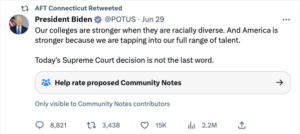Housing Advocates Rebuffed by Bob Duff
At the beginning of the 2023 legislative session, several initiatives were introduced to address the state’s housing shortage by further consolidating state control over housing and zoning policies. The National Low Income Housing Coalition reports that Connecticut is currently experiencing a deficit of 89,013 affordable housing units.
DesegregateCT — a coalition of activists advocating for zoning reform — emerged as a major advocate for state control over local zoning through mandates. They backed legislation that they felt would develop more jobs and homes around the state’s transit infrastructure.
The bill — which never made it to a vote — would have prioritized state grants to municipalities that complied with state mandates how many housing units would be built. Towns and cities with 60,000 or more people would have to allow 30 housing units per acre within half a mile of a train station. Those that met these goals would be first in line to receive state infrastructure grants.
Alexis Harrison, co-founder and president of CT169 Strong — a nonpartisan local control activist group — argues that towns and cities benefit from local zoning benefits communities “by ensuring consistency of land use, types of development in different zoning districts, and the pace of change, all of which preserves property values, enhances a town’s economic stability, protects historic and environmental resources, and governs the pace of change to a sustainable, supportable level.”
What ended up passing in the last three hours of the legislative session this year was a bill that requires the state to assess the regional need for more affordable housing. The mandate was left out…for now.
Both groups have good intentions in wanting to solve the state’s housing shortage and it would be great if they could come together in working through the issue. However, that is unlikely.
In a June 12 interview with Dan Newmyer of CT Politics TV, Senate Majority Leader Bob Duff (D-25) — representing Norwalk and Darien — opted to push the two sides further apart. Duff stated CT169 Strong has no ideas and called them “elitist.” He went on to add fuel to the fire by saying, “They’re just against everything,” and that he has “yet to see anything positive from them except a bunch of whining and crying.”
He then added that, “they just want the status quo,” accusing the group of not caring “because they have a house and they like their white picket fences” and that “they really have nothing to bring to the table except their elitism.”
Duff was so proud of his assessment of some of his constituents that he retweeted the exchange.
Tell Me You’re for School Choice Without Telling Me You Are for School Choice
The U.S. Supreme Court on Thursday (June 29) struck down affirmative action programs at the University of North Carolina and Harvard in the cases of Students for Fair Admissions, Inc. v. University of North Carolina and Students for Fair Admissions, Inc. v. President and Fellows of Harvard College.
The Court ruled that race-based affirmative action admission policies are unconstitutional and “unavoidably employ race in a negative manner, involve racial stereotyping and lack meaningful endpoints.”
Leaders in the state had a lot to say about the ruling.
Gov. Ned Lamont issued a statement saying, “This ruling takes our country backward by upending the hard work that has gone into removing barriers to educational advancement. College students learn from one another, and college campuses only benefit from diverse student bodies coming together to learn and grow.”
He also noted that the states’ public and private colleges have been preparing and will start “taking a holistic approach to the admissions process, including outreach to marginalized and underserved communities, developing a robust, culturally competent curriculum, and ensuring our student body and our staff are representative of all our communities.”
Lt. Gov. Susan Bysiewicz tweeted that “racism and discrimination remain rampant in our country, and it is incumbent on us all to promote diversity, inclusion — and equitable access to opportunity.”
The Connecticut American Federation of Teachers (AFT) did not issue a statement, but they did retweet President Joe Biden who said, “Our colleges are stronger when they are racially diverse. And America is stronger because we are tapping into our full range of talent.”
These statements sound a lot like those that come from supporters of school choice.
School choice provides marginalized communities, including low-income families and minority groups, more independence and control over their children’s education. By offering alternatives to traditional public schools — such as charter schools, voucher programs and educational scholarships — families can select schools that better align with their educational needs.
In many cases, students are forced into schools based on their zip code, which can perpetuate segregation and limited access to quality education. School choice initiatives can help break down these barriers by allowing students to attend schools outside their neighborhood or district. This enables students from different backgrounds to interact, learn, and collaborate, fostering a more inclusive and diverse learning environment.
Could these public declarations on the importance of diversity and equity indicate a genuine commitment to addressing the longstanding inequities within the public school system?
Less Bad is Still Bad
To address concerns expressed by Hartford city employees and retirees regarding their pension checks, Treasurer Carmen I. Sierra took the floor during the City Council meeting on Monday (June 26) and invoked her privilege to reassure them.
Sierra tried to explain that the city’s pension fund is in good shape, emphasizing that her foremost responsibility as treasurer is to fulfill the commitment of providing pensions to all 3,500 retirees.
She highlighted that over the past decade, Hartford’s pension fund achieved a 6.5 percent return, exceeding its target of 5.7 percent.
In the past seven years, Hartford has achieved a notable return of 7.3 percent, surpassing the benchmark of 6.5 percent. Similarly, over the last five years, the city’s return stood at 6.8 percent, exceeding the benchmark of 5.3 percent. However, in 2022, due to the impact of the pandemic and market decline, the city experienced a loss of 3.7 percent, while the benchmark was -3.3 percent.
The pensions fund return made a comeback in the last quarter of 2023 meeting its 4.4 percent benchmark. In response, Sierra said, “We are doing great.”
But is it really great?
Hartford’s pension fund is only 63.5 percent funded — which is, to be fair, far better than the State of Connecticut (44.0 percent), New Haven (32.7 percent) and Waterbury (55.4 percent). Meanwhile, the city pays $10 million a month into the fund, according to Sierra.
Although Hartford’s pension fund is less bad than other cities that doesn’t mean retirees shouldn’t be alarmed. Underfunded pension funds can lead to financial instability for retirees and could result in reduced pension benefits, delayed payments or even risk of the plan going bankrupt. Without adequate funding, pension funds may not be able to meet their long-term obligations causing increased contributions and benefit changes. Taxpayers may also be on the hook by being forced to pay additional taxes.
And there is cause for concern. Sierra admitted the city has seen a “big increase in the number of retirees” and “there are fewer employees paying into the pension.”
Hartford may also lose revenue based on the pandemic’s impact on the commercial office market. The city continues struggling with the increase in unoccupied commercial office space.
The Hartford Courant reported that as of Dec. 31, 2022, the overall office space available for lease was 23%, or 2.2 million square feet, according to CBRE — a commercial real estate service. Compare that to 18% at the end of 2019. However, in the 16 downtown office towers considered prime locations, the available space reached 34%, or 2 million square feet, by the end of 2022, compared with 21% just before the pandemic.
Hartford’s pension may be “great” today; however, city officials may want to revise that forecast. To avoid bankruptcy in 2018, the capital city had to receive a bailout of roughly $540 million by the state due to poorly handled finances. Connecticut taxpayers are not going to want to have to do that again.
Let’s hope Hartford ‘has it’ to fully right its pension issues before then.
Some Bad News
The Hartford Portfolio will be taking a week off but don’t fret it will be back at its regularly scheduled time in two weeks! Have a great Fourth of July!!!
This Week On Yankee’s Podcast Y CT Matters
In honor of Independence Day, Yankee Institute President Carol Platt Liebau talks to Prof. Mark David Hall about Connecticut’s Founding Father, Roger Sherman.
Click HERE to listen.




